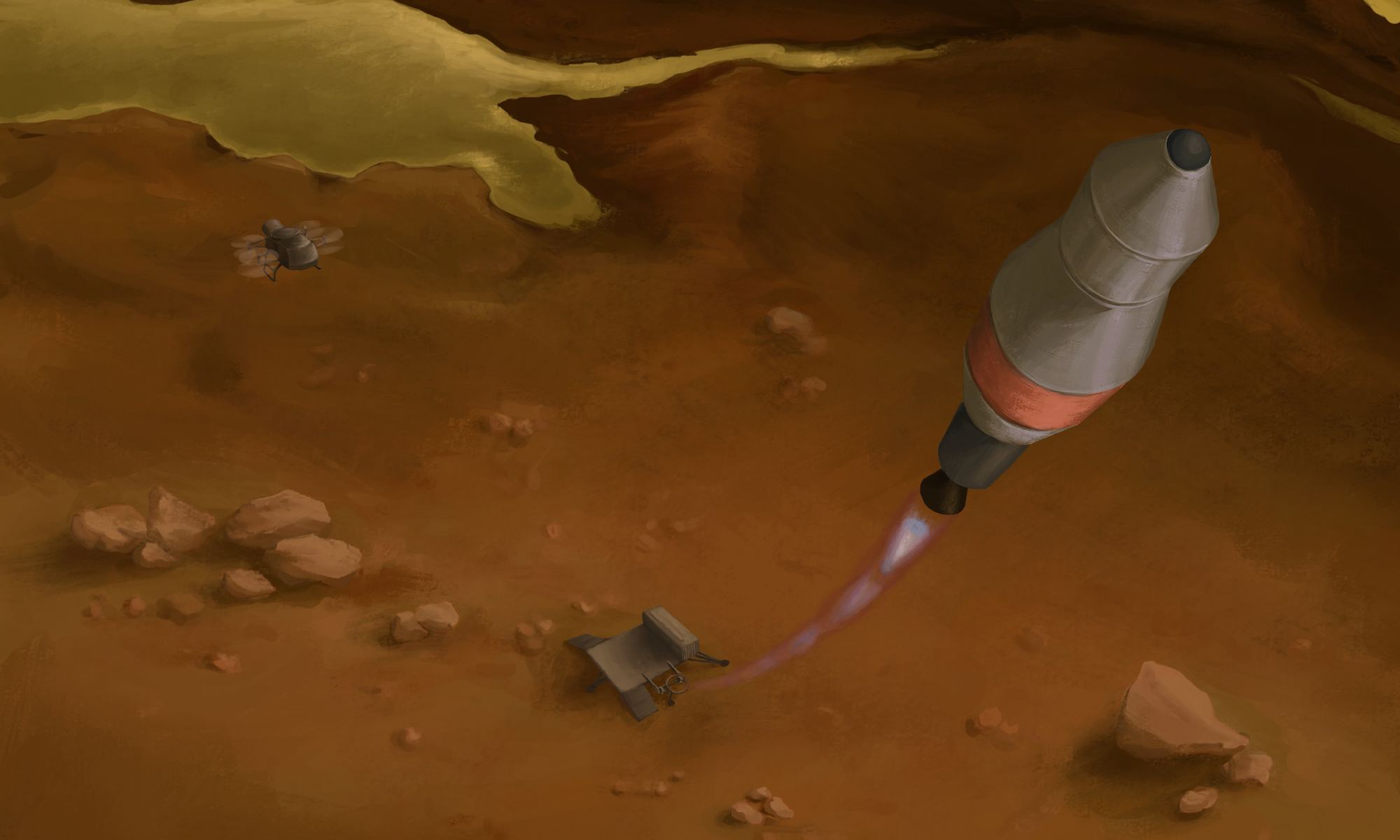Saturn’s largest moon, Titan, is a fascinating and mysterious world, a world literally shrouded in mystery due to thick clouds that cameras imaging in the visible spectrum cannot penetrate. This was made apparent when NASA’s Pioneer 11 became the first spacecraft to fly past Titan in 1979, and then NASA’s Voyager 1 and 2 in 1980 and 1981, respectively. All three spacecraft were equipped with cameras that were unable to penetrate Titan’s atmosphere of thick clouds, although atmospheric data from Voyager 1 suggested Titan might be the first body, aside from Earth, where liquid might exist on its surface.
Continue reading “Titan is an Alien World, but Surprisingly Familiar”A Titan Mission Could Refuel on Site and Return a Sample to Earth
This decade promises to be an exciting time for space exploration! Already, the Perseverance rover landed on Mars and began conducting science operations. Later this year, the next-generation James Webb Space Telescope, the Double Asteroid Redirection Test (DART), and Lucy spacecraft (the first mission to Jupiter’s Trojan asteroids) will launch. Before the decade is out, missions will also be sent to Europa and Titan to extend the search for signs of life in our Solar System.
Currently, NASA’s plan for exploring Titan (Saturn’s largest moon) is to send a nuclear-powered quadcopter to explore the atmosphere and surface (named Dragonfly). However, another possibility that was presented this year as part of the NASA Innovative Advanced Concepts (NIAC) program is to send a sample-return vehicle with Dragonfly that could fuel up using liquid methane harvested from Titan’s surface.
Continue reading “A Titan Mission Could Refuel on Site and Return a Sample to Earth”NASA is Going Back to Saturn’s Moon Titan, this Time With a Nuclear Battery-Powered Quadcopter
The official announcement has been made. NASA is sending the Dragonfly, its rotary-winged flying robot, to Titan. We’ll have to control our excitement for a while, though. The launch date isn’t until 2026.
Continue reading “NASA is Going Back to Saturn’s Moon Titan, this Time With a Nuclear Battery-Powered Quadcopter”Dragonfly Proposed to NASA as Daring New Frontiers Mission to Titan
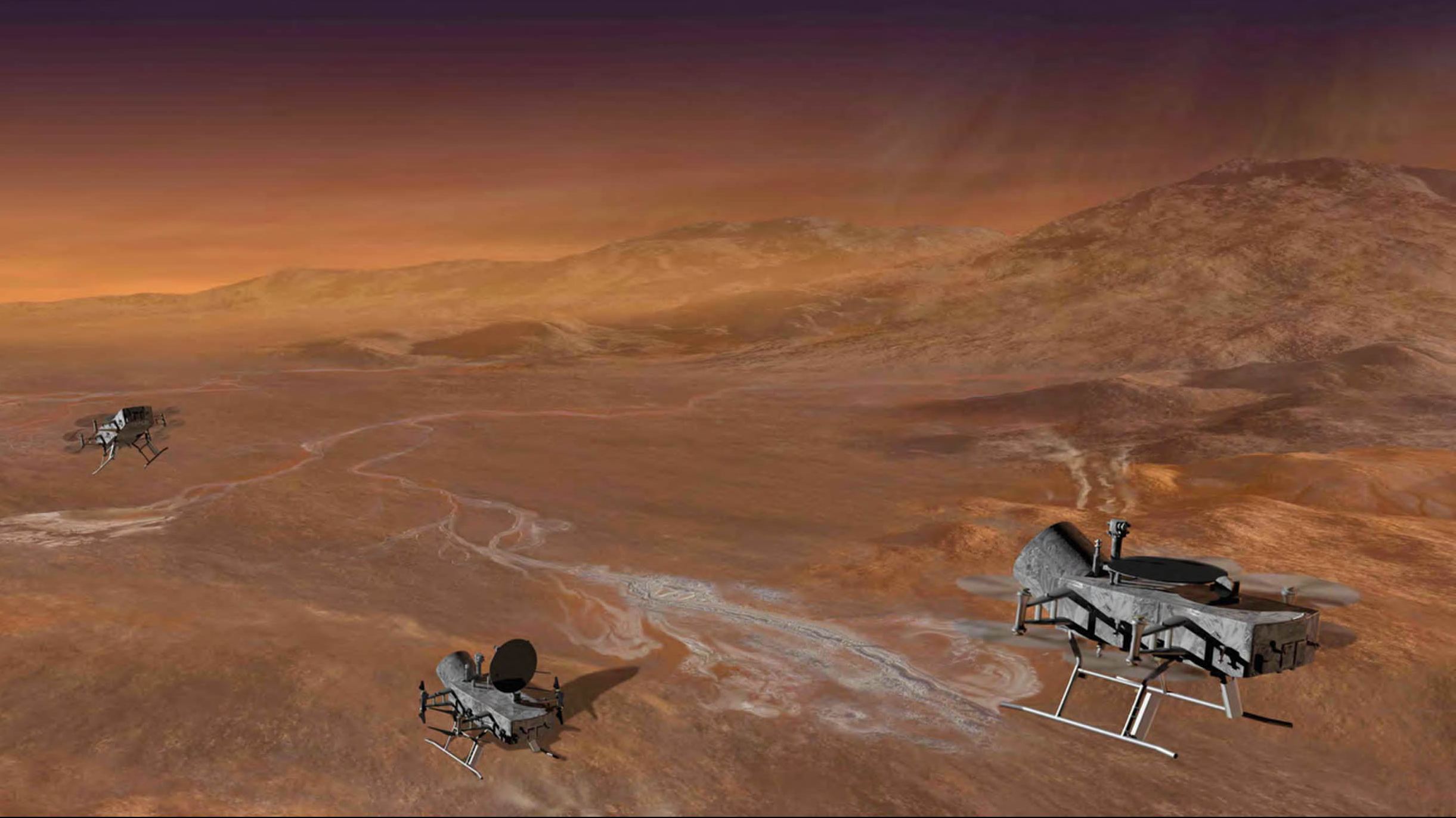
In late 1970s and early 80s, scientists got their first detailed look at Saturn’s largest moon Titan. Thanks to the Pioneer 11 probe, which was then followed by the Voyager 1 and 2 missions, the people of Earth were treated to images and readings of this mysterious moon. What these revealed was a cold satellite that nevertheless had a dense, nitrogen-rich atmosphere.
Thanks to the Cassini-Huygens mission, which reached Titan in July of 2004 and will be ending its mission on September 15th, the mysteries of this moon have only deepened. Hence why NASA hopes to send more missions there in the near future, like the Dragonfly concept. This craft is the work of the John Hopkins University Applied Physics Laboratory (JHUAPL), which they just submitted an official proposal for.
Essentially, Dragonfly would be a New Frontiers-class mission that would use a dual-quadcopter setup to get around. This would enable vertical-takeoff and landing (VTOL), ensuring that the vehicle would be capable of exploring Titan’s atmosphere and conducting science on the surface. And of course, it would also investigate Titan’s methane lakes to see what kind of chemistry is taking place within them.

The goal of all this would be to shed light on Titan’s mysterious environment, which not only has a methane cycle similar to Earth’s own water cycle, but is rich in prebiotic and organic chemistry. In short, Titan is an “ocean world” of our Solar System – along with Jupiter’s moons Europa and Ganymede, and Saturn’s moon of Enceladus – that could contain all the ingredients necessary for life.
What’s more, previous studies have shown that the moon is covered in rich deposits of organic material that are undergoing chemical processes, ones that might be similar to those that took place on Earth billions of years ago. Because of this, scientists have come to view Titan as a sort of planetary laboratory, where the chemical reactions that may have led to life on Earth could be studied.
As Elizabeth Turtle, a planetary scientist at JHUAPL and the principal investigator for the Dragonfly mission, told Universe Today via email:
“Titan offers abundant complex organics on the surface of a water-ice-dominated ocean world, making it an ideal destination to study prebiotic chemistry and to document the habitability of an extraterrestrial environment. Because Titan’s atmosphere obscures the surface at many wavelengths, we have limited information about the materials that make up the surface and how they’re processed. By making detailed surface composition measurements in multiple locations, Dragonfly would reveal what the surface is made of and how far prebiotic chemistry has progressed in environments that provide known key ingredients for life, identifying the chemical building blocks available and processes at work to produce biologically relevant compounds.”
In addition, Dragonfly would also use remote-sensing observations to characterize the geology of landing sites. In addition to providing context for the samples, it would also allow for seismic studies to determine the structure of the Titan and the presence of subsurface activity. Last, but not least, Dragonfly would use meteorology sensors and remote-sensing instruments to gather information on the planet’s atmospheric and surface conditions.
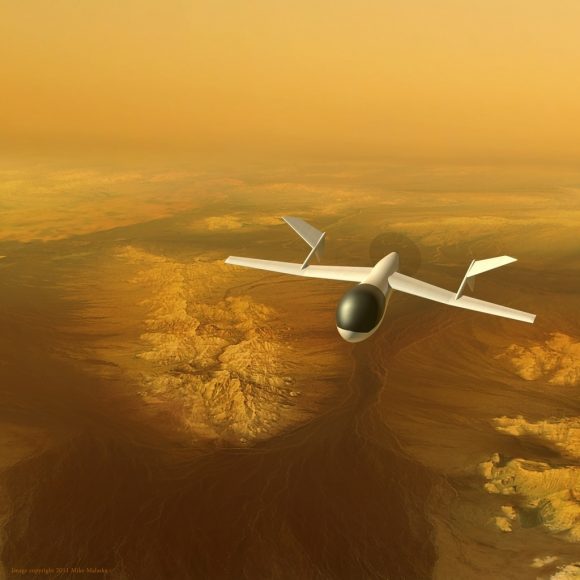
While multiple proposals have been made for a robotic explorer mission of Titan, most of these have taken the form of either an aerial platforms or a combination balloon and a lander. The Aerial Vehicle for In-situ and Airborne Titan Reconnaissance (AVIATR), a proposal made in the past by Jason Barnes and a team of researchers from the University of Idaho, is an example of the former.
In the latter category, you have concepts like the Titan Saturn System Mission (TSSM), a concept that was being jointly-developed by the European Space Agency (ESA) and NASA. An Outer Planets Flagship Mission concept, the design of the TSSM consisted of three elements – a NASA orbiter, an ESA-designed lander to explore Titan’s lakes, and an ESA-designed Montgolfiere balloon to explore its atmosphere.
What separates Dragonfly from these and other concepts is its ability to conduct aerial and ground-based studies with a single platform. As Dr. Turtle explained:
“Dragonfly would be an in situ mission to perform detailed measurements of Titan’s surface composition and conditions to understand the habitability of this unique organic-rich ocean world. We proposed a rotorcraft to take advantage of Titan’s dense, calm atmosphere and low gravity (which make flight easier on Titan than it is on Earth) to convey a capable suite of instruments from place to place — 10s to 100s of kilometers apart — to make measurements in different geologic settings. Unlike other aerial concepts that have been considered for Titan exploration (of which there have been several), Dragonfly would spend most of its time on the surface performing measurements, before flying to another site.”
Dragonfly‘s suite of instruments would include mass spectrometers to study the composition of the surface and atmosphere; gamma-ray spectrometers, which would measure the composition of the subsurface (i.e. looking for evidence of an interior ocean); meteorology and geophysics sensors, which would measure wind, atmospheric pressure, temperature and seismic activity; and a camera suite to snap pictures of the surface.
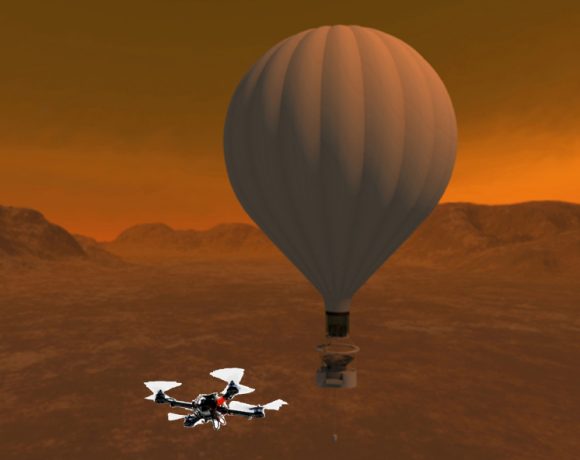
Given Titan’s dense atmosphere, solar cells would not be an effective option for a robotic mission. As such, the Dragonfly would rely on a Multi-Mission Radioisotope Thermoelectric Generator (MMRTG) for power, similar to what the Curiosity rover uses. While robotic missions that rely on nuclear power sources are not exactly cheap, they do enable missions that can last for years at a time and conduct invaluable research (as Curiosity has shown).
As Peter Bedini – the Program Manager at the JHUAPL Space Department and Dragonfly’s project manager – explained, this would allow for a long-term mission with significant returns:
“We could take a lander, put it on Titan, take these four measurements at one place, and significantly increase our understanding of Titan and similar moons. However, we can multiply the value of the mission if we add aerial mobility, which would enable us to access a variety of geologic settings, maximizing the science return and lowering mission risk by going over or around obstacles.”
In the end, a mission like Dragonfly would be able to investigate how far prebiotic chemistry has progressed on Titan. These types of experiments, where organic building blocks are combined and exposed to energy to see if life emerges, cannot be performed in a laboratory (mainly because of the timescales involved). As such, scientists hope to see how far things have progressed on Titan’s surface, where prebiotic conditions have existed for eons.
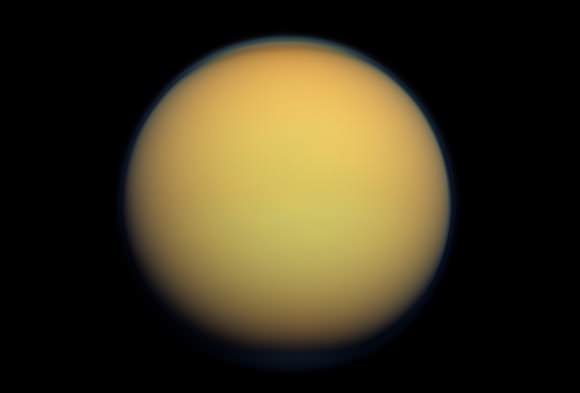
In addition, scientists will also be looking for chemical signatures that indicate the presence of water and/or hydrocarbon-based life. In the past, it has been speculated that life could exist within Titan’s interior, and that exotic methanogenic lifeforms could even exist on its surface. Finding evidence of such life would challenge our notions of where life can emerge, and greatly enhance the search for life within the Solar System and beyond.
As Dr. Turtle indicated, mission selection will be coming soon, and whether or not the Dragonfly mission will be sent to Titan should be decided in just a few years time:
“Later this fall, NASA will select a few of the proposed New Frontiers missions for further work in Phase A Concept Studies” she said. “Those studies would run for most of 2018, followed by another round of review. And the final selection of a flight mission would be in mid-2019… Missions proposed to this round of the New Frontiers Program would be scheduled to launch before the end of 2025.”
And be sure to check out this video of a possible Dragonfly mission, courtesy of the JHUAPL:
Further Reading: JHU Hub
Titan Ripe For Drone Invasion

With its dense and hydrocarbon-rich atmosphere, Titan has been a subject of interest for many decades. And with the success of the Cassini-Huygens mission, which began exploring Saturn and its system of moons back in 2004, there are many proposals on the table for follow-up missions that would explore the surface of Titan and its methane seas in greater depth.
The challenges that this presents have led to some rather novel ideas, ranging from balloons and landers to floating drones and submarines. But it is the proposal for a “Dragonfly” drone by researchers at NASA’s JHUAPL that seems particularly adventurous. This eight-bladed drone would be capable of vertical-takeoff and landing (VTOL), enabling it to explore both the atmosphere and the surface of Titan in the coming decades.
The mission concept was proposed by a science team led by Elizabeth Turtle, a planetary scientist from NASA’s Johns Hopkins University Applied Physics Laboratory (JHUAPL). Back in February, the concept was presented at the “Planetary Science Vision 2050 Workshop” – which took place at NASA’s headquarters in Washington, DC – and again in late March at the 48th Lunar and Planetary Science Conference in The Woodlands, Texas.
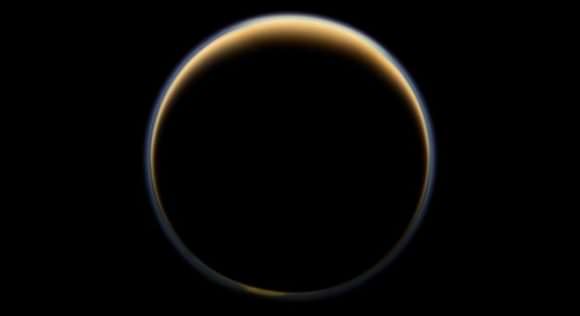
Credit: NASA/JPL-Caltech/Space Science Institute
Such a mission, as Turtle explained to Universe Today via email, is both timely and necessary. Not only would it build on many recent developments in robotic explorers (such as the Curiosity rover and the Cassini orbiter); but on Titan, there is simply no shortage of opportunities for scientific research. As she put it:
“Titan’s an ocean world with a unique twist, which is the rich and complex organic chemistry occurring in its atmosphere and on its surface. This combination makes Titan a particularly good target for studying planetary habitability. One of the big questions about the development of life is how chemical interactions led to biological processes. Titan’s been doing experiments in prebiotic chemistry for millions of years – timescales that are impossible to reproduce in the lab – and the results of these experiments are there to be collected.”
Their proposal is based in part on previous Decadal Surveys, such as the Campaign Strategy Working Group (CSWG) on Prebiotic Chemistry in the Outer Solar System. This survey emphasized that a mobile aerial vehicle (i.e an airship or a balloon) would well-suited to exploring Titan. Not only is Titan the only known body other than Earth that has a dense, nitrogen-rich atmosphere – four times as dense as Earth’s – but it’s gravity is also about 1/7th that of Earth’s.
However, balloons and airships would be unable to study Titan’s methane lakes, which are one of the most exciting draws as far as research into prebiotic chemistry goes. What’s more, an aerial vehicle would not be able to conduct in-situ chemical analysis of the surface, much like what the Mars Exploration Rovers (Spirit, Opportunity and Curiosity) have been doing on Mars.

As such, Turtle and her colleagues began looking for a proposal that represented the best of both worlds – i.e. an aerial platform and a lander. This was the genesis of the Dragonfly concept.
“Several different methods have been considered for in-situ aerial exploration of Titan (helicopters, different types of balloons, airplanes),” said Turtle. “Dragonfly takes advantage of the recent developments in multi-rotor aircraft to provide aerial mobility for a lander with a sophisticated payload. Because Dragonfly would be able to travel long distances – a few tens of kilometers at a time, and up to a few hundred kilometers over the course of the mission – it would be possible to make measurements at multiple sites with very different geologic histories.”
The mission is also in keeping with concepts that Turtle and her colleagues – which includes Ralph Lorenz (also from JHUAPL), Melissa Trainer of the Goddard Space Flight Center, and Jason Barnes of University of Idaho – have been exploring for years. In the past, they proposed a mission concept that would combine a Montgolfière-style balloon with a Pathfinder-like lander. Whereas the balloon would explore Titan from a low altitude, the lander would explore the surface up close.
By the 48th Lunar and Planetary Science Conference, they had officially unveiled their “Dragonfly” concept, which called for a qaudcopter to conduct both aerial and surface studies. This four-rotor vehicle, it was argued, would be able to take advantage of Titan’s thick atmosphere and low gravity to obtain samples and determine surface compositions in multiple geological settings.
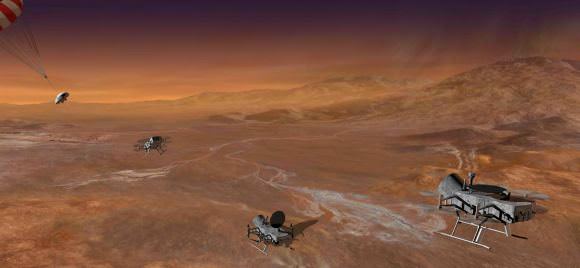
In its latest iteration, the Dragonfly incorporates eight rotors (two positioned at each of its four corners) to achieve and maintain flight. Much like the Curiosity and upcoming Mars 2020 rovers, the Dragonfly would be powered by a Multimission Radioisotope Thermoelectric Generator (MMRTG). This system uses the heat generated by decaying plutonium-238 to generate electricity, and can keep a robotic mission going for years.
This design, says Turtle, would offer scientists the ideal in-situ platform for studying Titan’s environment:
“Dragonfly would be able to measure compositional details of different surface materials, which would show how far organic chemistry has progressed in different environments. These measurements could also reveal chemical signatures of water-based life (like that on Earth) or even hydrocarbon-based life, if either were present on Titan. Dragonfly would also study Titan’s atmosphere, surface, and sub-surface to understand current geologic activity, how materials are transported, and the possibility of exchange of organic material between the surface and the interior water ocean.”
This concept incorporates a lot of recent advances in technology, which include modern control electronics and advances in commercial unmanned aerial vehicle (UAV) designs. On top of that, the Dragonfly would do away with chemically-powered retrorockets and could power-up between flights, giving it a potentially much longer lifespan.
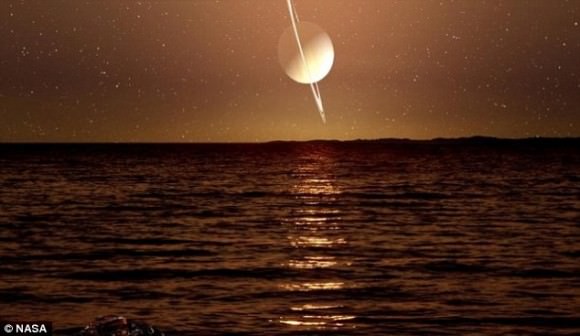
“And now is the perfect time,” says Turtle, “because we can build on what we’ve learned from the Cassini-Huygens mission to take the next steps in Titan exploration.”
Currently, NASA’s Jet Propulsion Laboratory is developing a similar concept. Known as the Mars Helicopter “Scout”, for use on Mars, this aerial drone is expected to be launched aboard the Mars 2020 mission. In this case, the design calls for two coaxial counter-rotating rotors, which would provide the best thrust-to-weight ratio in Mars’ thin atmosphere.
This sort of VTOL platform could become the mainstay in the coming decades, wherever long-term missions that involve bodies that have atmospheres are called for. Between Mars and Titan, such aerial drones could hop from one area to the next, obtaining samples for in-situ analysis and combining surface studies with atmospheric readings at various altitudes to get a more complete picture of the planet.


